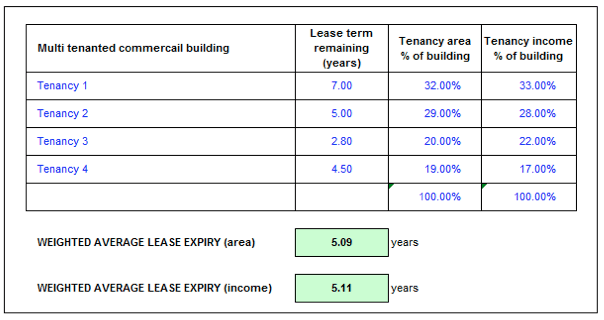Insights —
with vision

Monday, 20th October 2014
WALE; what does this common commercial property term mean to investors?
Commercial property investors may have seen the term WALE in property sales reports and wondered what this term means. The term WALE stands for ‘weighted average lease expiry’. The Property Council of Australia define a WALE as ‘the weighted average lease term remaining to expire across a portfolio, it can be weighted by rental income or square metres.’ Other abbreviations used are WALT (weighted average lease term), and WAULT (weighted average unexpired lease term). These two abbreviations are more common in America and Britain.
The term WALE is typically used on any commercial investment property with 2 or more tenants. The WALE is calculated across all the tenants in a property and is weighted by either the tenant’s lettable area or the tenant’s income against the total combined area or income of the other tenants.
Valuers typically calculate the WALE on both area and income, but property sales reports typically have only one WALE calculation. The main difference that occurs in the WALE for the area and income is with properties that have tenancies with different areas and rent rates, such as a shopping centre or office building with lower level retail tenancies.
The WALE can provide investors with the following information;
- An indication as to the future tenancy costs of the property. A higher WALE of 5+ years indicates that there may be limited short to medium term vacancies in the building. A lower WALE of 1 to 5 years indicates there may be an increased risk of a multiple vacancies in the short to medium term.
- Commercial buildings with a low WALE and short lease periods tend to have a high turnover of tenants. A higher turnover of tenants potentially leads to higher leasing costs such as; leasing agent fees, loss of income through vacancy periods, incentive payouts, advertising fees, legal fees, and valuers fees. These potential leasing costs can have a significant effect on the long term financial performance of these commercial buildings.
- Commercial buildings with a high WALE (4+ years) typically have larger corporate tenants who commit to leases of 5 years or more.
- Commercial buildings with a low WALE (1 to 4 years) typically have small to medium businesses who commit to leases no longer than 3 to 5 years.
- The WALE on a commercial building that has a major tenant who occupies a large proportion of the building is sensitive to the lease term of this major tenant as they have a high weighting across the other tenants in the building. For example, a shopping centre with a major tenant such as Woolworths or Coles who occupy 60% to 80% of the total tenancy area and have a 20 year lease, will typically show a high WALE (based on area) of 10+ years, even though the remainder of the tenants may on be on 3 to 5 year leases.
- The major tenant in a shopping centre will typically pay a lower rental rate than the specialty shops and as a result their weighting in terms of income may not be as high as their weighting by area. This means that the WALE (based on income) may be lower than the WALE (based on area).
Below is an example of a WALE calculation that has been conducted on a standard excel spreadsheet;

If you would like to learn more about the term WALE or how to set up your own WALE spreadsheet contact; Prosper Group on 1300 664 373 or enquiries@prospergroup.com.au